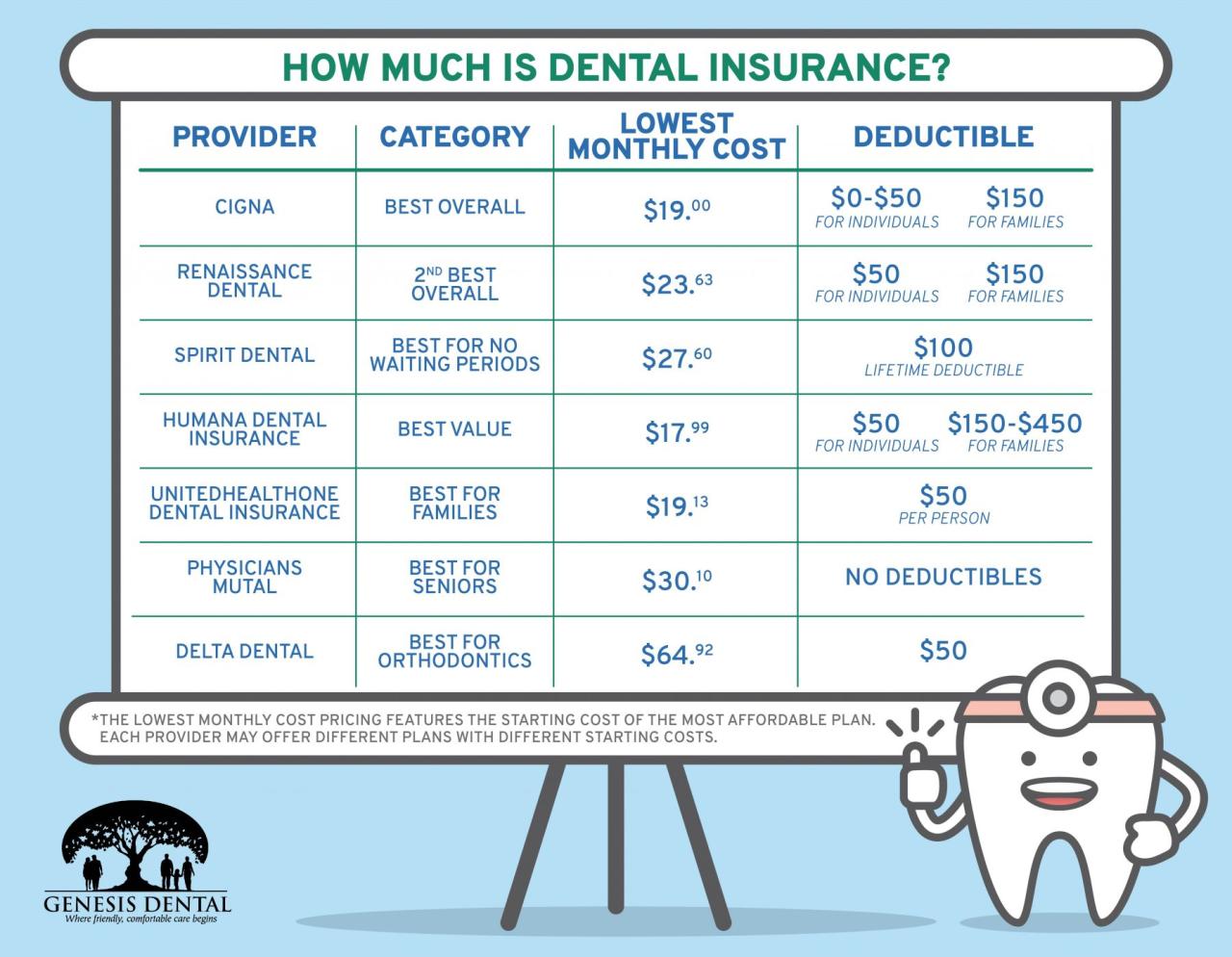Dental insurance plans are essential for protecting your oral health and wallet. They provide financial assistance for a range of dental services, from routine checkups to more complex procedures. Whether you’re looking for individual coverage, family plans, or employer-sponsored options, understanding the different types and features of dental insurance is crucial.
Navigating the world of dental insurance can seem daunting, with terms like deductibles, co-pays, and waiting periods. But by understanding the key aspects of these plans, you can make informed decisions that align with your needs and budget.
Understanding Dental Insurance Plans
Dental insurance is a valuable tool for managing the cost of oral healthcare. It provides financial protection against unexpected dental expenses, allowing individuals to access necessary treatment without breaking the bank. Dental insurance plans are contracts between an insurance company and an individual or group, where the insurer agrees to cover a portion of the cost of dental care in exchange for regular premium payments.
Types of Dental Insurance Plans
Dental insurance plans come in various forms, each tailored to different needs and circumstances. The most common types include:
- Individual Dental Insurance:This type of plan is purchased by individuals directly from an insurance company. It offers flexibility in choosing coverage options and allows individuals to tailor the plan to their specific needs.
- Family Dental Insurance:Family dental insurance plans cover multiple family members under a single policy. These plans typically offer discounted premiums and provide comprehensive coverage for the entire family.
- Employer-Sponsored Dental Insurance:Many employers offer dental insurance as part of their employee benefits package. These plans are often negotiated with insurance companies to provide competitive rates and comprehensive coverage for employees.
Common Dental Insurance Coverage
Dental insurance plans typically cover a range of dental services, including:
- Preventive Care:This includes routine checkups, cleanings, and dental x-rays, which are essential for maintaining good oral health and detecting potential problems early on.
- Restorative Treatments:Dental insurance plans often cover restorative treatments, such as fillings, crowns, and root canals, to repair damaged teeth and restore their function.
- Cosmetic Procedures:While some plans may offer limited coverage for cosmetic procedures like teeth whitening or veneers, these are generally not covered as extensively as preventive and restorative treatments.
Key Features of Dental Insurance Plans
Understanding the key features of dental insurance plans is crucial for making informed decisions about coverage and costs. These features include:
Deductibles
A deductible is the amount you must pay out-of-pocket before your insurance coverage kicks in. Once you’ve met your deductible, your insurance will begin covering a percentage of the remaining costs.
Co-pays
Co-pays are fixed amounts you pay for specific services, such as a dental checkup or cleaning. Co-pays are usually a smaller amount than deductibles and are designed to encourage regular preventive care.
Maximum Coverage Limits
Dental insurance plans have maximum coverage limits, which represent the total amount the insurer will pay for covered services within a policy year. Once you reach the maximum limit, you will be responsible for paying the remaining costs out-of-pocket.
Waiting Periods, Dental insurance plans
Waiting periods are the time you must wait after enrolling in a plan before certain services are covered. These periods typically apply to major procedures, such as crowns or dentures, and are designed to prevent people from signing up for insurance solely to cover pre-existing conditions.
Pre-existing Conditions
Pre-existing conditions are medical conditions you had before enrolling in a dental insurance plan. Some plans may exclude coverage for pre-existing conditions, or they may require you to wait a certain period before coverage applies.
Dental Networks and Preferred Providers
Many dental insurance plans operate within a network of dentists who have agreed to provide services at discounted rates. These networks are designed to help you find affordable dental care, but it’s important to ensure that your preferred dentist is included in the network.
Choosing the Right Dental Insurance Plan: Dental Insurance Plans
Selecting the right dental insurance plan is essential for ensuring you receive the coverage you need at a price that fits your budget. Here’s a step-by-step guide to help you make an informed decision:
Compare Different Dental Insurance Plans
Begin by comparing different dental insurance plans from reputable insurance companies. Look for plans that offer comprehensive coverage, reasonable premiums, and a network of dentists in your area.
Key Factors to Consider
| Factor | Description |
|---|---|
| Coverage | What types of dental services are covered, and what are the coverage limits? |
| Cost | What are the monthly premiums, deductibles, co-pays, and maximum coverage limits? |
| Provider Network | Is your preferred dentist included in the plan’s network? |
| Waiting Periods | Are there any waiting periods for specific services? |
| Pre-existing Conditions | Does the plan cover pre-existing conditions? |
Evaluate Suitability for Individual Needs and Budget
Once you’ve gathered information on different plans, carefully evaluate their suitability for your individual needs and budget. Consider your current oral health status, anticipated dental care needs, and financial constraints.
Utilizing Dental Insurance Benefits
Once you’ve chosen a dental insurance plan, it’s important to understand how to utilize its benefits effectively. Here’s a checklist of steps to follow:
Checklist for Utilizing Dental Insurance Benefits
- Choose an in-network dentist:Selecting a dentist within your plan’s network ensures you receive discounted rates.
- Schedule regular checkups:Preventive care is typically covered at a higher percentage, so scheduling regular checkups and cleanings can help maximize your coverage.
- Understand your coverage:Familiarize yourself with your plan’s coverage details, including deductibles, co-pays, and maximum coverage limits.
- File claims promptly:After receiving dental services, file claims promptly to ensure timely reimbursement.
- Keep track of your benefits:Monitor your remaining coverage and out-of-pocket expenses to avoid surprises.
Tips for Maximizing Coverage and Minimizing Out-of-Pocket Expenses
- Ask about pre-authorization:For major procedures, inquire about pre-authorization to ensure coverage and prevent unexpected costs.
- Consider preventive care:Regular checkups and cleanings can help prevent more serious dental problems, reducing the need for expensive restorative treatments.
- Shop around for services:Compare prices for dental services among different providers to find the most affordable options.
- Negotiate payment plans:If you have high out-of-pocket costs, discuss payment plans with your dentist to spread out payments over time.
Filing Claims and Understanding Reimbursement Procedures
Filing dental insurance claims is typically a straightforward process. Your dentist’s office will usually handle the paperwork, but it’s helpful to understand the basic procedures. When you receive dental services, your dentist will provide you with a claim form. Fill out the form accurately and submit it to your insurance company.
Life insurance can be a bit of a confusing topic, but it’s important to understand. It’s basically a safety net for your loved ones, providing financial support if something unexpected happens to you. You can learn more about different types of life insurance and how they work to make sure you’re making the right choice for your situation.
Your insurer will review the claim and process reimbursement according to your plan’s terms.
Dental Insurance for Different Lifestyles

Dental insurance needs vary depending on individual lifestyles and circumstances. Here’s a breakdown of how dental insurance can benefit different groups:
Young Adults
Young adults often have limited financial resources, making dental insurance essential for managing the cost of routine care and unexpected dental emergencies. Many employers offer dental insurance as part of their benefits package, providing a valuable resource for young professionals.
Families
Families with children are particularly vulnerable to dental expenses, as children are more prone to dental issues. Family dental insurance plans provide comprehensive coverage for the entire family, ensuring access to affordable dental care for everyone.
Seniors
As individuals age, their dental needs may increase. Dental insurance can help seniors afford necessary treatments, such as dentures, implants, or bridges, to maintain their oral health and overall well-being.
Life insurance is a crucial part of financial planning, providing a safety net for your loved ones in case of your unexpected passing. If you’re unsure about the best policy for your needs, you can find helpful information and resources on life insurance at the MDBP website.
Individuals with Specific Health Conditions or Needs
Individuals with certain health conditions, such as diabetes or autoimmune disorders, may require specialized dental care. Dental insurance can help cover the cost of these treatments, ensuring they receive the necessary care to manage their condition.
Dental Insurance Plans Tailored to Different Lifestyles and Situations
There are a variety of dental insurance plans tailored to different lifestyles and situations. For example, some plans offer coverage for specific procedures, such as implants or orthodontics, while others may focus on preventive care. It’s essential to choose a plan that aligns with your individual needs and budget.
Final Wrap-Up
Ultimately, choosing the right dental insurance plan is about finding the best balance between coverage, cost, and provider network. By taking the time to compare options, you can secure the protection you need to maintain a healthy smile and avoid unexpected dental expenses.
Remember, preventative care is key, and dental insurance can help you prioritize your oral health.













